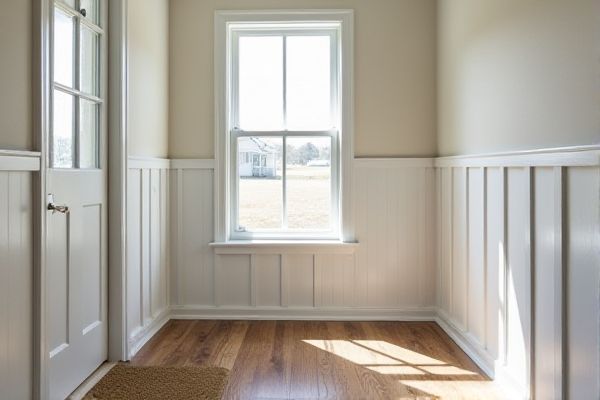
Shiplap features horizontal wooden boards with a distinctive groove design that creates a clean, rustic look, while wainscoting typically consists of decorative panels or molding installed on the lower part of walls for added texture and elegance. Discover how choosing between shiplap and wainscoting can transform Your interior and enhance your home's style by reading the rest of this article.
Table of Comparison
| Feature | Shiplap | Wainscoting |
|---|---|---|
| Material | Wood or MDF boards with rabbeted edges | Wood panels, beadboard, or MDF, often with trim |
| Design Style | Horizontal overlapping planks, rustic and modern farmhouse | Classic paneled walls, traditional or colonial style |
| Installation Height | Floor to ceiling or partial walls | Typically lower third of wall, around 32-42 inches high |
| Purpose | Wall covering for texture and style | Wall protection and decorative paneling |
| Cost | Moderate, varies by material and finish | Moderate to high, depends on panel complexity |
| Maintenance | Easy to clean, repaintable | Requires occasional painting and cleaning |
| Common Uses | Interior walls, accent walls, ceilings | Dining rooms, bathrooms, hallways |
Introduction to Shiplap and Wainscoting
Shiplap consists of horizontal wooden boards with a rabbeted edge, creating a tight, overlapping fit that adds texture and rustic charm to walls. Wainscoting involves decorative paneling, typically installed on the lower half of walls, enhancing architectural detail and protecting surfaces from damage. Your choice between shiplap and wainscoting depends on whether you want a casual farmhouse look or a more formal, traditional design element.
Key Differences Between Shiplap and Wainscoting
Shiplap features horizontal wooden boards with a rabbet joint that creates a distinctive gap, ideal for a rustic or farmhouse style, while wainscoting consists of decorative panels covering the lower portion of walls for an elegant, traditional look. Shiplap is typically installed full wall or ceiling height, offering a textured surface, whereas wainscoting is often limited to chair rail height, combining panels, molding, and trim for classic architectural detail. Your choice depends on desired aesthetic and functional use, with shiplap enhancing casual warmth and wainscoting adding formal sophistication.
Material and Construction Comparison
Shiplap is typically made from wood or MDF boards with rabbeted edges that overlap, creating a tight seal and a smooth, horizontal appearance ideal for modern farmhouse or rustic styles. Wainscoting involves raised or flat panels framed with trim, often constructed from solid wood, MDF, or PVC, offering more texture and architectural detail suitable for traditional or formal interiors. Your choice depends on whether you prefer the sleek, linear look of shiplap or the classic, three-dimensional effect provided by wainscoting.
Design Styles: Modern vs. Traditional
Shiplap features clean, horizontal lines that complement modern, minimalist design styles by adding texture without overwhelming the space. Wainscoting offers detailed paneling and molding, which aligns well with traditional and classic interiors, providing an elegant, timeless look. Choosing between shiplap and wainscoting depends on whether the desired aesthetic is contemporary simplicity or historic refinement.
Cost Comparison: Shiplap vs. Wainscoting
Shiplap typically costs between $3 and $8 per square foot, making it a budget-friendly option for wall paneling, while wainscoting ranges from $10 to $20 per square foot due to its more intricate design and installation requirements. Your choice may impact overall renovation expenses, with shiplap offering a cost-effective solution for a modern farmhouse aesthetic and wainscoting providing a classic, upscale look that increases home value. Labor costs for wainscoting are generally higher because of the detailed craftsmanship involved, whereas shiplap installation is quicker and more straightforward.
Installation Process and DIY Considerations
Shiplap installation involves horizontally overlapping wooden boards that require precise measurement and cutting but is generally straightforward with basic tools, making it suitable for DIY beginners. Wainscoting installation demands detailed panel fitting, molding attachment, and sometimes intricate carpentry skills, often necessitating professional assistance for optimal results. DIY enthusiasts should consider their experience level; shiplap offers quicker setup and simpler maintenance, while wainscoting provides a more decorative finish but requires advanced skill and time investment.
Durability and Maintenance Needs
Shiplap is made from overlapping wooden boards, offering strong resistance to moisture and warping, which makes it durable and easy to maintain with occasional dusting and repainting. Wainscoting, typically crafted from MDF or hardwood panels, provides a robust protective layer on walls that resists dents and scratches but may require more frequent cleaning and periodic sealing to prevent damage. Both materials enhance wall longevity, but shiplap's simpler installation and upkeep make it ideal for high-moisture or high-traffic areas.
Best Room Applications for Each Option
Shiplap works best in living rooms, kitchens, and bathrooms where a rustic, farmhouse, or coastal aesthetic is desired, offering horizontal lines that create a sense of spaciousness. Wainscoting is ideal for dining rooms, hallways, and formal sitting areas, providing an elegant, classic look that adds architectural detail and protects lower walls from scuffs. Your choice depends on the room's function and style, with shiplap enhancing casual warmth and wainscoting elevating traditional sophistication.
Pros and Cons: Shiplap vs. Wainscoting
Shiplap offers a rustic, seamless look with horizontal planks that are easy to install and maintain, but it may show gaps over time due to wood expansion. Wainscoting provides classic elegance and can protect lower walls from damage, yet it often requires more customization and can be pricier to install. Your choice depends on whether you prioritize a modern farmhouse aesthetic with shiplap or a traditional, durable wall treatment with wainscoting.
Which is Right for Your Home?
Shiplap offers a smooth, horizontal plank design that enhances rustic or modern farmhouse styles, while wainscoting provides a classic, paneled look ideal for traditional or elegant interiors. Your choice depends on the desired aesthetic and functional needs, such as moisture resistance in bathrooms favoring wainscoting's durability. Consider your home's architectural style, room function, and texture preference to determine whether shiplap's casual charm or wainscoting's refined detail best suits your space.
 homyna.com
homyna.com